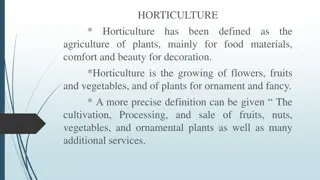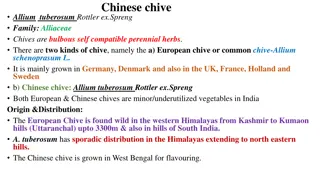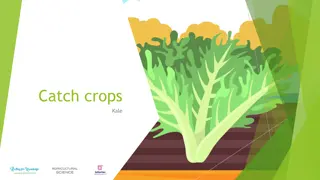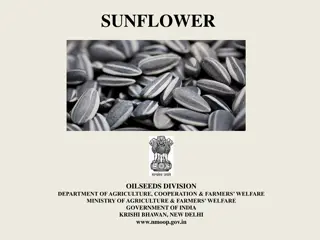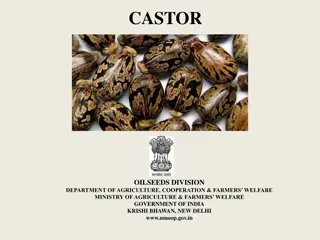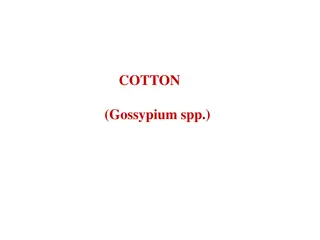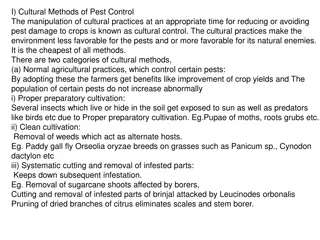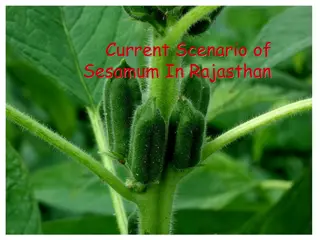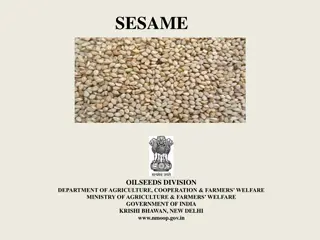Jute Cultivation in India: A Comprehensive Overview
Jute is a significant natural fiber crop cultivated extensively in India, primarily in the fertile Ganges Delta shared with Bangladesh. This article discusses the cultivation conditions, growth requirements, methods of cultivation, processing techniques, and India's position as a leading jute producer. With a focus on the geographical aspects influencing jute cultivation, it sheds light on the economic and industrial importance of this versatile fiber.
Download Presentation

Please find below an Image/Link to download the presentation.
The content on the website is provided AS IS for your information and personal use only. It may not be sold, licensed, or shared on other websites without obtaining consent from the author.If you encounter any issues during the download, it is possible that the publisher has removed the file from their server.
You are allowed to download the files provided on this website for personal or commercial use, subject to the condition that they are used lawfully. All files are the property of their respective owners.
The content on the website is provided AS IS for your information and personal use only. It may not be sold, licensed, or shared on other websites without obtaining consent from the author.
E N D
Presentation Transcript
S. MAHESWARI S. MAHESWARI GUEST LECTURER IN GEOGRAPHY GUEST LECTURER IN GEOGRAPHY GOVERNMENT COLLEGE FOR WOMEN(A) GOVERNMENT COLLEGE FOR WOMEN(A) KUMBAKONAM KUMBAKONAM GEOGRAPHY OF INDIA GEOGRAPHY OF INDIA III B.Sc. GEOGRAPHY TITLE : JUTE IN INDIA 10.09.2020
JUTE IN INDIA JUTE IN INDIA Jute is one of the important natural fibers after cotton in terms of cultivation and usage. Cultivation is dependent on the climate, season, and soil. Almost 85% of the world's jute cultivation is concentrated in the Ganges Delta. This fertile geographic region is shared by both Bangladesh and India. This fertile geographic both Bangladesh and India (mainly West Bengal). China also has a dominating place in jute scale, Thailand, Myanmar and Bhutan also cultivate jute. It is used for manufacturing a large variety of articles such as gunny bags, hessian, ropes, strings, carpets, rugs and clothes, tarpaulins, upholstery and decoration pieces. region is shared by cultivation. (Burma), On Pakistan, a smaller Nepal,
Conditions of Growth: Jute is the crop of hot and humid climate. It requires high temperature varying from 24 C to 35 C and heavy rainfall of 120 to 150 cm with 80 to 90 per cent relative humidity during the period of its growth Small amount of pre-monsoon rainfall varying from 25 cm to 55 cm is very useful because it helps in the proper growth of the plant till the arrival of the proper monsoon. Incessant and untimely rainfalls as well as prolonged droughts are detrimental to this crop. Rainfall between 2.5 to 7.5 cm in a month, during the sowing period, is considered to be sufficient. Light sandy or clayey loams are considered to be best suited soils for jute. Since jute rapidly exhausts the fertility of soil, it is necessary that the soil is replenished annually by the silt-laden flood water of the rivers. Large supply of cheap labour is also necessary for growing and processing the jute fibre.
Method of Cultivating and Processing of Jute: Jute is generally sown in February on lowlands and in March- May on uplands. The crop takes 8- 10 months to mature but different varieties take different time to mature. The harvesting period generally starts in July and continues till October. The plants are cut to the ground and tied into bundles. Sheafs of jute stocks are then immersed in flood water or ponds or stagnant water for about 2 to 3 weeks for retting. High temperature of water quickens the process of retting. After retting is complete, the bark is peeled from the plant and fibre is removed. After this, stripping, rinsing, washing and cleaning is done and the fibre is dried in the sun and pressed into bales. All this process is to be done by human hand for which/availability of plenty of labour at cheap rates is very essential. Luckily, this labour is readily available because jute is cultivated in areas of high population density.
Production of Jute Production of Jute India has taken advantage of recent improvements in the cultivation of jute to become the largest producer or cultivator of jute in the world. Using advanced production techniques, India also has dominance over the products market. Due to national law to use jute as packaging materials, India is the largest consumer of jute in the world. worldwide jute
Production of Jute in India Production of Jute in India
Distribution: 1. West Bengal: West Bengal is the undisputed king of jute production in India accounting for over four-fifths of the production and nearly three- fourths of the area under jute. Here hot and humid climate and alluvial, loamy soil coupled with cheap abundant labour provide the par excellence conditions for the growth of jute. Almost all parts of the state are producing some jute but its cultivation decreases in the north sub-Himalayan region, towards the south in the Ganga delta where land is too low for jute and towards the west where the rocky ground of the Deccan plateau is more marked than the Ganga alluvium. However, major part of the production comes from Nadia, Murshidabad, 24 Parganas, Coochbehar, Jalpaiguri, Hugli, West Dinajpur, Bardhaman, Maldah and Medinipur districts. The entire jute production is consumed in the jute mills located in the Hugli basin. In 2002-03, West Bengal produced 85.06 lakh bales of jute.
2. Bihar: Bihar is the second largest producer but lagging far behind West Bengal in the production of jute accounting only for about 9.72 per cent of the production and over 17 per cent of the area of the country under jute. Purnea is the largest producing district accounting for 60 per cent of Bihar s production. Katihar, Saharsa and Darbhanga are the other producing districts. 3. Assam: With about 6.68 per cent of the production and 7.88 per cent of the area of the country, Assam is the third largest jute producing state of India. The main concentration is in the Brahmaputra and Surma valleys. Goalpara, Kamrup, Nowgong, Darrang and Sibsagar are the main producing districts.
Others: Among the other producers, is Orissa, where Cuttack, Puri and Bolangir producers. In Uttar Pradesh, areas along the Himalayan foothills including Kheri, Bahraich and Sitapur districts are the main producers. Some jute is also produced in Maharashtra, Kerala, Madhya Pradesh, Tripura, Meghalaya and Andhra Pradesh. are the main
Trade: India s production of jute always falls short of her requirements and it is imported to feed our jute mills. Bangladesh is the chief supplier of jute to India. There are year to year fluctuations in the quantity and value of jute imported by India. Being a natural fibre, jute is biodegradable and as such environment friendly . The principal products can be reused and, as a result, many have a secondary value for other users. Despite such positive features, the world market for jute has remained depressed. The primary cause of such a situation is the development of substitutes like plastic.
THANK YOU THANK YOU



